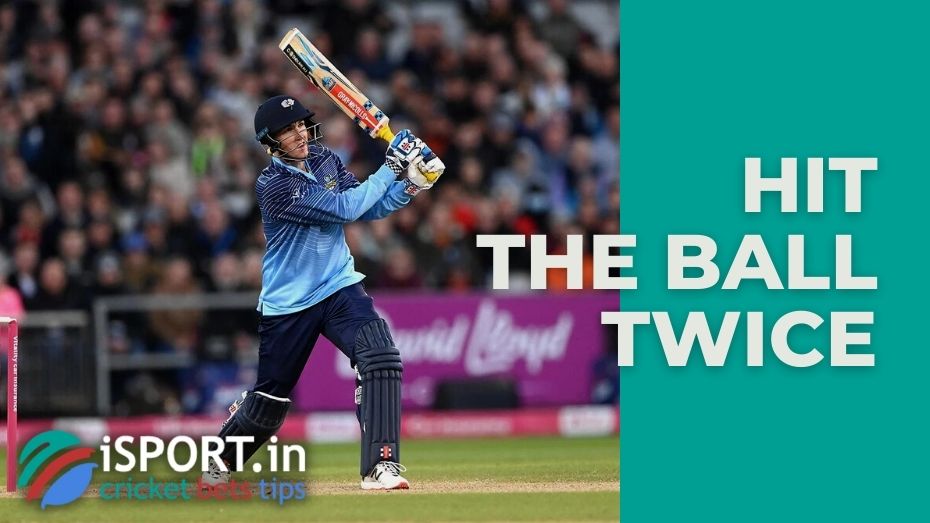Hit the ball twice

Hit the ball twice, also known as double-hit is one of the reasons for removing a player in modern cricket. It is extremely rare.
Hit the Ball Twice: Regulations
However, there is a separate paragraph on this in the set of rules:
34.1.1. The striker shall be sent off if the ball in play touches any part of his / her body or bat, after which the player strikes a second without waiting for it to touch an outfield player. The only exception is wicket protection.
34.1.2. In this case, hitting means contact with the player who is kicking the ball. At the end of the episode, bowlers do not receive any additional benefits.
A player can hit the ball twice if it helps protect the hand, but not the one in contact with the bat, and not to prevent the opponent from catching the ball.
Due to the fact that contemporary cricket is considered to be a low-risk sport in which players seldom sustain significant injuries that may put their careers in jeopardy, this limitation may seem to be excessive and even bizarre at first look. Hit the ball twice was included in the rulebook despite the fact that, at the time when cricket was not yet a full-fledged sport but was largely a game that was growing popularity, batsmen were willing to do everything in order to avoid having the rule removed.
Due to the fact that they often struck the ball a great deal in order to preserve the wicket, which sometimes led to injuries being sustained by opponents, it was decided to create a basic ban list in order to assist in reducing the hazards that the outfield players were exposed to in the end.
Hit the Ball Twice: Examples
There have been many documented instances in which hitting the ball twice resulted in severe injuries or even fatalities. For instance, on May 5, 1622, seven members of the Church in Boxgrove (West Sussex) were convicted for playing cricket in the parish graveyard. Both of these incidents occurred on the same day. The remaining case file indicates that the charge was comprised of three points, which are as follows:
- The behavior of the participants was contrary to local law;
- Playing near the church building could damage valuable stained-glass windows;
- One of the young spectators accidentally got hit by a bat, which literally “blew his brains out”.
Two years later, another sad event took place in the eastern part of the county, which ultimately led to the death of Jasper Vinall’s fielder. The first known fatality of a fielder on the court occurred when the hitter, whose name was Edward Ty, attempted to smash the ball with a bat for a second time and struck an opponent in the head.
It was decided that the matter should be sent to the coroner, who thereafter rendered the verdict of “accident.” An additional fielder named Henry Brand was slain in the year 1647, which finally led to cricket players contemplating the possibility of instituting a unique rule that would assist in preventing events of a similar kind in the future.
Unfortunately, the precise date of its implementation is unknown (it is presumed that the first edition of the “Rules of Cricket” in 1744 was based on an earlier version of the code, which was later lost), but the first deletion was recorded for Hit the ball twice in 1786, which occurred during the match between the Hampshire and the Kent. This was the first time that the code was altered. Tom Suter, a member of the first team, was disqualified.
In light of the fact that the term hit the ball twice is used so seldom in modern times, it is important to emphasize that all circumstances are known to a lesser degree. When Lester’s player John King attempted to carry out an injury in a match against Surrey in 1906, after receiving a double hit, he became one of the most renowned players in the history of the sport.
Hit the Ball Twice: Ineffectiveness
The ineffectiveness of such strategy made the term hit the ball twice about as unpopular as Timed out, according to those who are knowledgeable about the game. They also point out that King could have continued to play on the field if it weren’t for this disciplinary action.
It is interesting: even modern technologies do not always make it possible to prove that the double blow was inflicted deliberately. For example, in the 2002-2003 season in the Barbados match against the Remaining Leeward Islands (Red Stripe Bowl), first-team player Kurt Wilkinson was sent off, although his intentions remained unclear to the judges.
